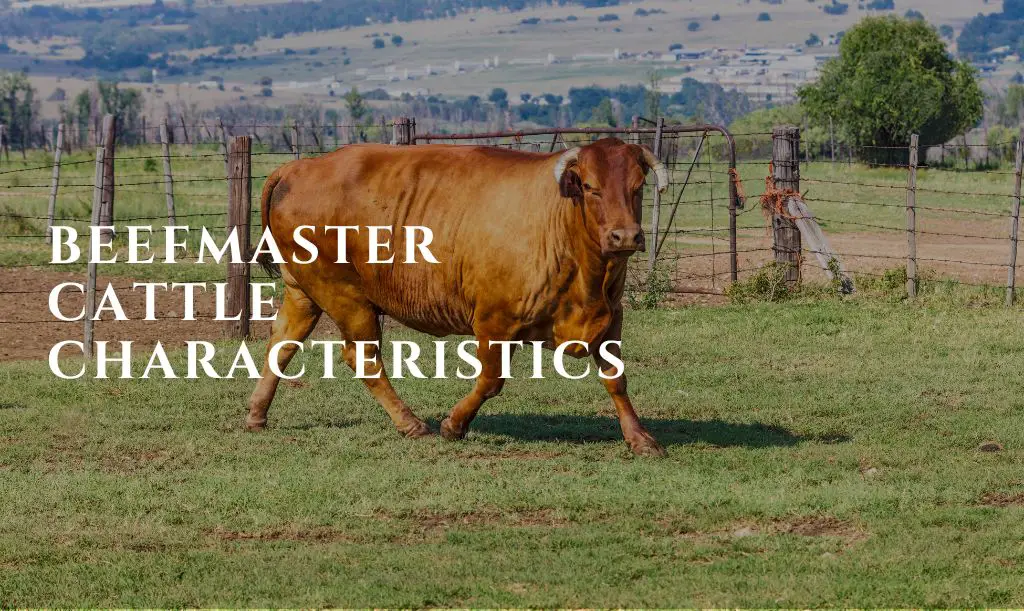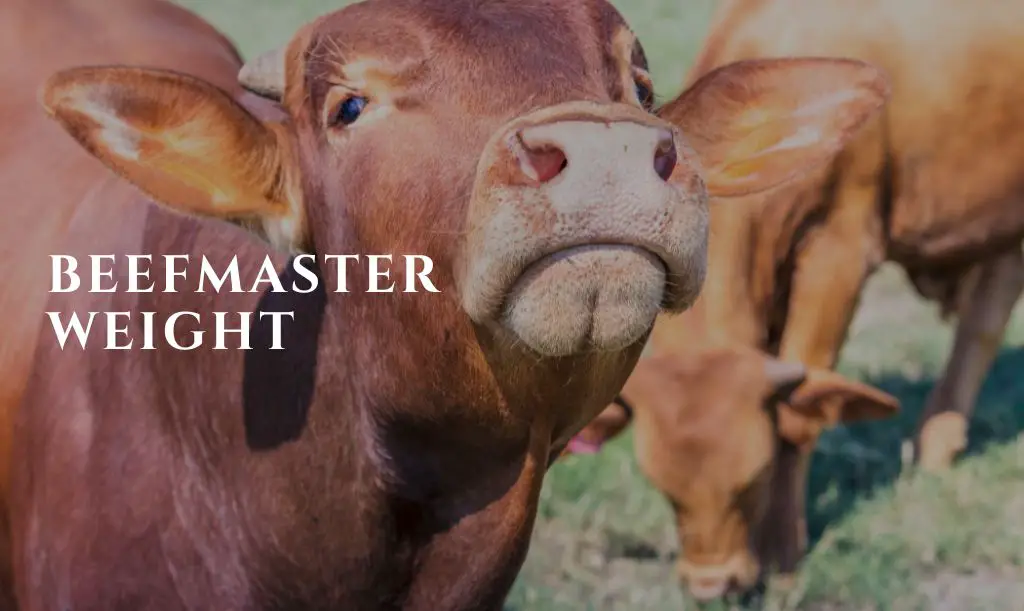The majestic and noble Beefmaster cattle! Allow me to introduce you to these magnificent creatures that grace our pastures.
These beasts are a sight to behold, with their imposing size and robust physique.
Now, I must admit, I have a soft spot for these animals. They truly embody the essence of strength and power.
So what exactly are Beefmaster cattle? Well, my dear readers, they are a breed that was developed in the early 1900s by Tom Lasater in Texas.
Lasater sought to create a superior all-purpose breed that would excel in both beef production and adaptability to various climates.
And boy, did he succeed!
The Beefmasters combine the best qualities of three distinct breeds: Hereford, Shorthorn, and Brahman.
In this article, we’ll talk about their rich history, impressive physical attributes, unique qualities, disadvantages, and more.
So stay tuned!
Key Takeaways
- Beefmaster cattle are a breed known for their adaptability to different climates and environments.
- They exhibit good growth rates and efficient feed conversion, making them suitable for beef production.
- Beefmaster cattle have excellent maternal instincts and are commonly used in crossbreeding programs to enhance maternal characteristics in herds.
- While Beefmaster cattle may have slightly lower marbling compared to some other breeds, their meat still offers lean and flavorful characteristics.
- They are known for their docile temperament and established market demand for their high-quality beef.
- Proper feeding, handling, and cooking techniques can enhance the flavor and tenderness of Beefmaster beef.
- Beefmaster cattle contribute to the diversity and productivity of beef herds, particularly in regions with varying climates and environmental conditions.
What Are Beefmaster Cattle
Beefmaster cattle are an absolute marvel of nature.
These magnificent creatures are a hybrid breed, carefully crafted by the genius minds of breeders who sought to create the ultimate beef-producing animal.
In essence, beefmaster cattle are a crossbreed between Brahman cattle and Hereford or Shorthorn cattle.
This combination results in a bovine powerhouse that possesses the best traits from both parent breeds.
Now, let’s delve into why beefmaster cattle are truly exceptional.
First and foremost, their resilience and adaptability to various climates is simply awe-inspiring. Thanks to their Brahman lineage, these animals can withstand extreme temperatures with ease.
Whether it’s scorching heat or bone-chilling cold, beefmaster cattle remain unfazed and continue to thrive in almost any environment.
But that’s not all; their exceptional foraging abilities make them self-sufficient grazers like no other breed out there.
Beefmaster cattle possess an innate instinct to efficiently convert forage into high-quality meat products.
This means they require less supplemental feed than other breeds while still producing top-notch beef with excellent marbling and taste.
Moreover, these animals boast remarkable maternal qualities.
The nurturing instincts of the Hereford or Shorthorn side come into play here, as beefmaster cows are known for their exceptional mothering abilities.
They exhibit strong protective behaviors towards their calves and possess ample milk production capabilities to ensure the well-being of their offspring.
This nurturing nature not only ensures healthy growth but also contributes to the overall success of any beef operation.
These hybrid wonders bring together strength, adaptability, incredible grazing abilities, and outstanding maternal qualities – all wrapped up in one magnificent package!
It is no wonder that they have gained popularity among ranchers worldwide as a superior choice for meat production.
Disadvantages Of Beefmaster Cattle
Now, don’t get me wrong, I understand the appeal of beefmaster cattle. They are revered for their muscular build and ability to thrive in harsh environments.
However, let’s not overlook the undeniable drawbacks that come with these cattle. It’s time we shed some light on the less talked about downsides of raising beefmasters.
First and foremost, one cannot ignore the temperament of these creatures. Beefmaster cattle have a notorious reputation for being unruly and difficult to handle.
Their aggressive nature can turn a peaceful ranch into a chaotic battleground in no time. Wrangling these feisty beasts requires nerves of steel and an arsenal of patience.
If you’re looking for docile and mild-mannered animals, then steer clear (pun intended) of beefmasters. Another major drawback is their high feed consumption rate.
These voracious eaters can empty your wallet faster than you can say “feed bill.”
Be prepared to spend a significant chunk of your budget on providing sufficient nourishment for these insatiable creatures. It’s like feeding an army!
And considering the skyrocketing prices of hay and grain, maintaining beefmasters can become an expensive endeavor.
Additionally, let’s talk about their reproductive efficiency.
Or should I say inefficiency? Despite claims that beefmasters are excellent breeders, many ranchers have found themselves disappointed by the low conception rates observed in their herds.
This reproductive challenge not only hampers breeding programs but also leads to financial losses due to missed opportunities for expanding one’s herd size.
Furthermore, let me touch upon a less discussed disadvantage – health issues plagued by beefmaster cattle.
These animals are prone to various ailments such as respiratory problems, foot rot infections, and even genetic disorders like dwarfism or fertility issues that can be passed down through generations.
Dealing with veterinary treatments and ensuring overall herd health becomes an additional burden on any dedicated rancher.
While beefmaster cattle certainly have some redeeming qualities, it is essential to consider the disadvantages before diving headfirst into raising them.
From their aggressive temperament to their insatiable appetite and reproductive challenges, one must be prepared to invest not only financially but also mentally and emotionally.
Characteristics Of Beefmaster Cattle

When it comes to the characteristics of beefmaster cattle, there is no denying their sheer greatness and superiority.
These magnificent creatures possess a unique blend of traits that makes them stand head and shoulders above other cattle breeds.
From their imposing size to their exceptional adaptability, beefmasters are truly in a league of their own.
First and foremost, let’s talk about the size of these beasts.
Beefmaster cattle are renowned for their impressive stature. They have a muscular build with broad chests and strong legs that exude power and dominance.
On average, an adult beefmaster bull can weigh anywhere between 1,800 to 2,500 pounds, while cows usually tip the scales at around 1,100 to 1,400 pounds.
This remarkable size not only makes them awe-inspiring to behold but also ensures that they can withstand rigorous workloads and endure harsh environmental conditions without breaking a sweat.
Another notable characteristic of beefmasters is their unparalleled adaptability.
These resilient creatures have been bred for generations in various climates and terrains, which has bestowed upon them an incredible ability to thrive in diverse environments.
Whether they are faced with scorching heat or freezing cold temperatures, arid deserts or lush pastures, beefmasters can navigate through adverse conditions with remarkable ease.
Their adaptability also extends to different types of vegetation as they possess a strong foraging ability that allows them to derive sustenance from even the most meager pastures.
Beefmaster Cattle Color
When it comes to the color of these majestic creatures, there is one word that comes to mind: diversity.
The wide range of colors exhibited by beefmaster cattle is a testament to their extraordinary genetic makeup.
Whether you prefer the deep, rich hues of black or brown, or the strikingly vibrant shades of red or brindle, beefmaster cattle have it all.
Allow me to delve into the enchanting realm of beefmaster cattle color.
Let’s start with the classic black coat. Picture a sleek and velvety creature, standing proud and powerful against a backdrop of green pasture.
The obsidian shine emanating from every inch of their body is simply awe-inspiring.
It’s as if they were forged in the depths of an ancient volcano, infused with an otherworldly darkness that demands reverence.
On the other end of the spectrum lies the captivating beauty of brown beefmaster cattle. Imagine a sun-kissed landscape brought to life in animal form.
Their warm tones exude an earthy elegance that cannot be ignored.
With each step they take, their coats shimmer like fallen leaves on an autumn afternoon, reminding us why nature itself has always been considered an artist.
But let us not forget about the mesmerizing red beefmasters. These magnificent creatures are like living flames that ignite our fascination and admiration.
With coats ranging from fiery oranges to deep crimsons, they command attention wherever they go.
It’s almost as if they carry within them a hidden power – a symbol of strength and passion that defines them as true rulers of their domain.
And then there are those adorned with brindle patterns – a kaleidoscope of colors interwoven on their mesmerizing hide like strokes on a masterful painting.
Each swirl and stripe tells its own story – unique and mysterious in its own right – making every brindle beefmaster a walking work of art.
Beefmaster Cattle Horned or Polled
Horned or polled beefmaster cattle has long been a subject of contention among livestock enthusiasts, and I am here to voice my firm opinion on the matter.
Firstly, let us address the notion of horned beefmaster cattle.
To some, the sight of glorious horns adorning these majestic creatures is nothing short of breathtaking.
The horns symbolize strength and power, harking back to their ancestral roots as formidable beasts roaming the wilds.
They evoke a sense of awe and respect for these magnificent animals. Not to mention that they can be quite useful for self-defense and establishing dominance within the herd hierarchy.
On the other hand, there are those who argue in favor of polled beefmaster cattle – those without horns.
Admittedly, there are certain advantages to this seemingly more civilized approach.
Without horns, they present less risk for handlers and fellow animals alike during routine handling procedures.
Additionally, eliminating horns reduces the chances of injuries resulting from accidental encounters or aggressive behavior within the herd.
However, I must say that removing an integral part of their natural anatomy feels akin to stripping them off their identity and heritage as true descendants of their wild predecessors.
It is as if we are attempting to mold them solely for our convenience rather than appreciating their inherent beauty in its entirety.
While I understand the practicality behind breeding polled beefmaster cattle for safety purposes in certain situations – such as crowded feedlots or intensive farming systems – there is an undeniable charm and authenticity in allowing these regal creatures to showcase their magnificent set of horns.
Let us not strip them off this symbol of strength and grace but embrace it instead while respecting their nature and providing suitable conditions for coexistence with humans.
How Much Do Beefmaster Cattle Weigh

When it comes to the weight of beefmaster cattle, brace yourself for a staggering display of sheer mass.
These magnificent beasts effortlessly tip the scales at an average range of 1,200 to 1,700 pounds.
Yes, you heard me right – we’re talking about behemoths on hooves! It’s as if they have their own gravitational pull when they walk.
Now, I understand that some may argue that size doesn’t always equate to quality or taste, but let me tell you something – there’s something undeniably impressive about witnessing such raw power in action.
But hold your horses!
We’re not done discussing weight just yet. We must delve deeper into the specifics.
Within this vast range exist variations based on factors such as age and gender. A mature beefmaster bull typically weighs between 1,500 to 2,000 pounds!
Picture that for a moment – a colossal creature roaming the pastures with an undeniable aura of dominance.
As for the ladies of this breed, they weigh in at around 1,000 to 1,400 pounds – still substantial by any measure.
Now, I know what some skeptics might say: “Who cares about weight? It’s all about the quality of meat!”
And while I respect different opinions (although they may be wrong), let me emphasize that weight plays a significant role in determining yield and value when it comes to these cattle.
The sheer size signifies an abundance of well-marbled meat that can satiate even the most voracious carnivorous appetite.
– yes indeed – beefmaster cattle are absolute powerhouses when it comes to weight.
These robust creatures embody strength and resilience in every fiber of their being (and boy, do they have a lot of fiber!).
How Much Do Beefmaster Cattle Cost
The burning question that haunts every aspiring beefmaster cattle owner: how much do these majestic creatures actually cost? Well, my dear readers, brace yourselves for a reality check.
Beefmaster cattle do not come cheap, and they certainly aren’t for the faint of heart or the shallow of pocket.
Let’s delve into the world of bovine economics, shall we? When it comes to purchasing beefmaster cattle, you’ll find that prices can vary depending on various factors.
First and foremost, pedigree plays a significant role in determining the price tag attached to these beasts.
If you’re looking for purebred beefmaster cattle with impeccable bloodlines and a prestigious lineage, be prepared to part with a substantial sum of money.
These elite specimens are highly sought after by breeders and enthusiasts alike, driving their prices through the roof. But wait!
Don’t despair just yet; there is hope for those on a tighter budget. You see, not all beefmaster cattle come with an exorbitant price tag.
Some breeders offer commercial-grade beefmasters that are more affordable but still possess many desirable traits.
While they may lack in pedigree glamour, these hardy animals can still serve admirably in ranching operations without breaking the bank.
Now let’s talk numbers! A top-tier purebred beefmaster bull can set you back anywhere from $5,000 to $15,000 or even more!
Yes, my friends, your eyes read that correctly – we’re talking five figures here.
And don’t think that heifers are any cheaper; even the finest females can command prices ranging from $3,000 to $10,000 depending on their attributes.
Of course, it’s worth noting that these figures are merely estimates and can fluctuate based on market demand and supply dynamics.
It’s always advisable to do your due diligence and shop around before making such a momentous investment.
Prices may be more forgiving if you opt for younger animals or purchase them in bulk.
However, it’s crucial to remember that owning beefmaster cattle is not just a monetary commitment; it requires a deep passion for these creatures and a genuine desire to contribute to the preservation of this remarkable breed.
So, if you’re embarking on the journey of owning beefmaster cattle, be prepared to open your wallets wide.
The cost of these magnificent animals may seem extravagant, but their worth extends far beyond mere dollars and cents.
Conclusion
It is evident that beefmaster cattle possess numerous advantages that make them a top choice for livestock farmers.
Their exceptional adaptability to various climates and efficient feed conversion rates contribute to their economic viability.
Additionally, their resilience against common diseases and parasites reduces the need for extensive veterinary interventions, saving both time and money.
However, it is important to acknowledge the drawbacks of beefmaster cattle as well. One major disadvantage lies in their temperament.
While some may argue that they are just spirited animals, I can confidently say that dealing with an unruly beefmaster bull is no walk in the park.
Their strong-willed nature can pose challenges during handling and must be approached with caution.
Furthermore, despite the wide array of colors present within the beefmaster breed, I personally believe that nothing compares to the elegant appearance of a solid red or black coat.
As much as some breeders may try to convince you otherwise, these vibrant hues display a certain majesty and make a bold statement in any pasture.
Other colors may be unique or eye-catching, but they simply cannot match the regal allure of a solid red or black beefmaster. While there are both pros and cons when it comes to beefmaster cattle, there is no denying their overall value as livestock.
They possess characteristics that facilitate profitability while minimizing some common challenges faced by farmers.
So if you’re considering adding these bovine beauties to your herd, embrace their spirited nature and revel in their stunning coats – for with patience and admiration for this majestic breed, success shall surely follow!
Related Articles:
FAQs
What are the 3 characteristics of Beefmaster?
The three key characteristics of Beefmaster cattle are adaptability, growth, and maternal instincts. Beefmasters are known for their ability to thrive in various climates and environments. They exhibit good growth rates, efficient feed conversion, and have excellent maternal instincts, making them valuable for beef production and crossbreeding programs.
What are the advantages and disadvantages of Beefmaster?
Beefmaster cattle offer advantages such as adaptability to different climates, good growth rates, efficient feed conversion, and excellent maternal instincts. They are commonly used in crossbreeding programs to enhance beef production and maternal characteristics. However, a potential disadvantage is that Beefmasters may have slightly lower marbling compared to some other breeds, impacting the level of marbling and tenderness in their meat. It’s important to consider these factors when evaluating the suitability of Beefmaster for specific production goals.
- Do Goats Sound Like Humans? Find Out Here! - 22 December 2023
- Vegetable Oil For Constipated Goat (Comprehensive Guide) - 22 December 2023
- Is Bermuda Hay Good For Goats? (Solved!) - 21 December 2023


